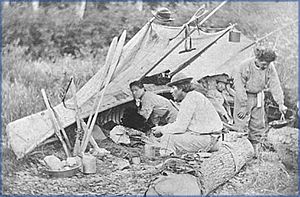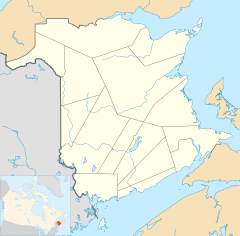Tobique First Nation facts for kids
Quick facts for kids
Tobique First Nation
Wolastoqiyik Neqotkuk
|
|
|---|---|
| Country | Canada |
| Province | New Brunswick |
| County | Victoria County |
| Established | 1801 |
| Area | |
| • Land | 27.24 km2 (10.52 sq mi) |
| Population
(December 31, 2008)
|
|
| • Total | 1,948 |
| Time zone | UTC-4 (Atlantic (AST)) |
| • Summer (DST) | UTC-3 (ADT) |
| Postal code span: | |
The Tobique First Nation (Malecite-Passamaquoddy: Wolastoqiyik Neqotkuk) is one of six Wolastoqiyik or Maliseet Nation reserves in New Brunswick, Canada.
The Tobique Reserve is located on the north side of the Tobique River. It includes two main areas: The Brother's #18 (4 hectares) and Tobique #20 (2724 hectares). The Tobique Reserve was created in 1801 with almost 20,000 acres. This happened after the community asked the government for land. Over time, the reserve lost land due to people settling on it without permission and a big land surrender in 1892. Today, about two-thirds of the Tobique First Nation members live on these reserve lands.
In 2009, the government agreed to discuss the Tobique Specific Land Claim. This claim is about 10,533 acres that the First Nation believes they lost unfairly in 1892. The Canadian government and the First Nation, along with the provincial government, are now working to agree on a payment plan. It's important to know that people who own land there now will not be affected.
Contents
History of Tobique First Nation Land

A survey in 1854 showed that the original Tobique reserve was 18,394 acres. The Tobique community lost 2,539 acres in the town of Perth because people settled there before and after Canada became a country. They also claim they lost 10,433 acres in what they call the "1892 Surrender." This is a big part of their land claim.
The 1892 Land Surrender Claim
In 1890, the government of New Brunswick wanted to open a large part of the Tobique Reserve for new settlers who were not Indigenous. To do this, the government arranged a land surrender in 1892. However, this surrender was done without a special approval called an "Order in Council." This approval was a necessary step for the surrender to be legal.
The surrender involved land "south of the Tobique river," except for 200 acres called "Indian Meadows." The government sold most of this land to individuals. But 169 acres were given back to the Tobique community in 1965.
The Tobique First Nation has been working hard on these land issues. They have filed two special claims. One is for the 2,539 acres lost in Perth. The other is for more than 10,000 acres lost in the 1892 surrender. This amount was almost two-thirds of their land.
On May 23, 2008, Canada agreed to negotiate only the second claim, known as the Tobique Specific Land Claim. This was because the government found that the 1892 surrender was not valid. Under the negotiation rules, the government and the First Nation have three years to agree on a payment plan. People who own property there now will not be affected. The settlement will not involve taking away their land. The First Nation is seeking fair payment for the land's value and for not being able to use it from 1867 to 2009.
Challenges with New Brunswick Power
The Tobique First Nation and the New Brunswick Power Corporation (NB Power) have often disagreed about how land and water are used. NB Power is a company owned by the government that provides electricity.
The First Nation did not agree to the company building a hydro-electric dam on the Tobique River in 1844 and again in 1895. But by 1945, the provincial and federal governments had started building a dam called the Tobique Narrows Dam.
In 1950, the leader of New Brunswick approved building the Mactaquac Dam without the Tobique First Nation's permission, even though they were the legal landowners. The dam started working in 1953. The Tobique community had offered in 1945 to settle all disagreements if they could use the dam's power for free for all homes and businesses on the reserve. However, this offer was never honored. As soon as the community got power lines, they started getting electricity bills. The Band Council paid these bills for Elders and community members who needed help. In 2008, the Tobique community started refusing to pay for the electricity made by the dam on their land. They also said the dam has caused environmental problems.
Protests and Negotiations
In 2008, the Tobique community began protesting by refusing to pay their electricity bills from NB Power. They also demanded that the company remove construction waste from the reserve. This waste included barrels with harmful chemicals and other pollutants from when the dam was built.
When NB Power threatened to cut off electricity to the reserve, some residents set up a blockade at the dam. They required NB Power trucks to check in with the Nation before entering. In 2009, things became more tense when an NB Power truck did not stop at a roadblock. Members of the Nation then took control of the NB Power truck.
On June 30, 2009, the provincial Minister of Aboriginal Affairs promised to pay for cleaning up the harmful waste around the dam. They also agreed to fix riverbanks that had been damaged. The dams on the St. John's River have greatly reduced the number of Atlantic Salmon. This has made it harder for the Tobique people to get food and has hurt the local economy.
As the blockade continued into its third month in the summer of 2009, the Canadian government agreed to negotiate the Tobique First Nation's specific land claim. This claim is expected to be one of the largest in Atlantic Canada. The Tobique community wanted to share in the benefits from the dam. They wanted some electricity to be available for free to reserve residents, and possibly for them to sell some power too.
NB Power offered to solve the dispute by providing up to 5 megawatts of power from the dam. The dam produces about 20 megawatts. This offer is currently being considered. However, with modern technology, the river could produce much more power, possibly hundreds of megawatts.
Notable People from Tobique First Nation
- Andrea Bear Nicholas: A professor of Native Studies since 1993 at St. Thomas University. She helped create the first university program in North America to train teachers in Indigenous language immersion.
- Sandra Lovelace Nicholas: An activist who fought for the rights of Indigenous women and children. She is a Canadian Senator and has received the Order of Canada award.
- Graydon Nicholas: The first Indigenous Lieutenant-Governor of New Brunswick. He used to represent the King or Queen in the province.
- Shirley Bear: A feminist, activist, and artist. She received the Order of Canada in 2011 for her work on Maliseet-language films shown on APTN.
- Jeff Bear: A producer of independent documentaries. He produced four Maliseet-language films shown on APTN.
- Jeremy Dutcher: A classically-trained Canadian Indigenous singer, composer, music expert, performer, and activist. He has won a Juno Award.


